CASE 1
https://swathibogari158.blogspot.com/2020/09/chronic-decompensated-liver-disease.html
Q1 Reason for this patients ascites
Ans- Ascites is caused by increased pressure in the veins in the liver (portal hypertension) and decrease in liver function caused by scarring of the liver(cirrhosis)
In this patient
due to alcohol misuse
Being overweight. Being obese increases your risk of conditions that may lead to cirrhosis, such as nonalcoholic fatty liver disease and nonalcoholic steatohepatitis.
Because of liver disease,its functions are comprimised.so,albumin is decreased which leads to decrease in colloidal osmotic pressure leading to fluid accumulation.
2) Why did the patient develop bipedal lymphedema? What was the reason for the recurrent blebs and ulcerations and cellulitis in his lower limbs?
Ans-due to filariasis
The filarial worms block and prevents lymph fluid from draining well, and the fluid buildup leads to swelling.cellulitis
and lymphoedema is a vicious cycle
where each episode of cellulitis further
damages the lymphatic system, leading
to a degree of secondary lymphoedema,
which in turn constitutes an increased
risk for cellulitis .
3) What was the reason for his asterixis and constructional apraxia and what was done by the treating team to address that?
Asterixis ,sign of hepatic encephalopathy, damage to brain cells due to the inability of the liver to metabolize ammonia to urea. The cause is thought to be predominantly related to abnormal ammonia metabolism.
He was given rifamixin and lactulose
4) What was the efficacy of each treatment intervention used for this patient? Identify the over and under diagnosis and over and under treatment issues in the management of this patient.
Ans- A. high protein diet (2eggs / day) for decreased albumin synthesis
B. Air or water bed to prevent pressure bed sores in the dependent areas
C. Fluid restriction <1.5litres/day so as to decrease of fluid dissemination into the extra vascular space
D. Salt restriction <2.4gms/day to prevent retention of water.
E. Inj augmentin 1.2gm IV/BD to prevent secondary bacterial infections
F. Inj pan 40 mg IV/OD
G. Inj zofer 4mg IV/BD
H. Tab. Lasilactone (20/50)mg BD ( combination of furosemide and aldactone to decrease pedal oedema
If SBP <90mmhg - to avoid excessive loss of fluid
I. Inj vit k 10mg IM/ STAT ( as vitamin K causes coagulation to further prevent bleeding manifestions
J. Syp lactulose 15ml/PO/BD for hepatic encephalopathy
K. Tab udiliv 300mg/PO/BD contain Ursodeoxycholic acid as an active ingredient. It is used to dissolve gall stones in various liver-related disorders such as cirrhosis
L. Syp.hepamers 15ml/po/od
M. IVF 1 NS slowly at 30ml/hr to maintain hydration
N. Inj thiamine 100mg in 100mlNS /IV/TID as thiamine deficiency's occur in chronic alcoholics
O. Strict BP/PR/TEMP/Spo2 CHARTING HOURLY
P. Strict I/O charting
Q. GRBS 6th hourly
R. Protein powder in glass of milk TID for protein supplementation and muscle wasting which commonly occurs in cirrhosis patients
S. 2FFP and 1PRBC transfusion to support coagulation pathways
T. ASD DONE for wound infections and ulcer
CASE 2
https://sainiharika469.blogspot.com/2020/09/hello-everyone.html?m=1
1) Why were his antitubercular therapy stopped soon after his current admission? Was he symptomatic for ATT induced hepatitis? Was the method planned for restarting antitubercular therapy after a gap of few days appropriate? What evidence is this approach supported by?
Ans-ATT was stopped because his LFT was deranged, Total Bilirubin raised and ALP was also raised. Serum albumin is also low.
2) What were the investigational findings confirming the diagnosis of pulmonary TB in this man?
Ans- Bilateral infiltration of lung fields noted in chest X-Ray (PA view)
3) What was the cause of his ascites?
Ans. Portal Hypertension ??
4) What are the efficacy of each intervention mentioned in his treatment plan and identify the over and under diagnosis as well as over and under treatment issues in it.
Ans.
High protein diet 4eggs daily for protein supplementation
ORS sachets in 1 litre of water to compensate electrolytes lost due to diarrhoea
Inj PIPTAZ 4.5gm for antibiotic cover
Vit k 10 mg Iv OD for 5 days to prevent forthcoming bleeding manifestations as his PT INR APTT are elevated
IVF - 1 DNS @50ml/hr for hydration
Nebulisation with salbutamol and mucomist 12th hourly for cough and crepts
Inj thiamine 100 mg in 100 ml NS IV TID. for chronic alcoholism.
CASE 3
https://sushma29.blogspot.com/2020/09/ascites-secondary-to-nephrotic-syndrome.html?m=1
1) What will be your further approach toward managing this patient of nephrotic syndrome? How will you establish the cause for his nephrotic syndrome?
Ans-The treatment for nephrotic syndrome is steroids
If this is steroid sensitive nephrotic syndrome the patient responds to the drugs
The steroids are started and they are slowly tapered as per the requirement
The cause for nephrotic syndrome maybe primary which is idiopathic or secondary such as
Glomerular pathology,diabetes ,cancer ,drugs ,infections and some congenital diseases
2) What are the pros and cons of getting a renal biopsy for him? Will it really meet his actual requirements that can put him on the road to recovery?
Ans-Renal biopsy would be really helpful if the nephrotic syndrome is due to any glomerular pathology
There are disadvantages to the renal biopsy such as affordability of the patient,time taking,and the post biopsy complications.


Comments
Post a Comment